The evolution of the Macintosh (and the iMac)
We outline the transformation of Apple's most formative desktop computer, from the first Mac to the latest iMac Pro.
![The Evolution of the Macintosh [slideshow cover]](https://images.techhive.com/images/article/2016/01/evolution_of_the_macintosh_01-100639457-gallery.idge.jpg)
Computerworld
The Evolution of the Macintosh
It's been more than 30 years since the arrival of Apple’s Macintosh computer -- the Mac -- which has evolved substantially, especially over the past decade. (And as of today, it's been 20 years since the first iMac was unveiled.) From only 128KB of memory in the first Mac (to an optional 128GB in the latest iMac Pro), Apple has continually redefined its products from design and aesthetics to functionality and productivity. The Mac now accounts for 7.5% of the declining PC market, with sales continuing to outperform sales of Windows PCs. Here we take a look at the Mac’s evolution throughout the past three decades, with a focus on the rapid changes of the last decade or so, especially as the iMac grew and evolved beyond its original gumdrop design.
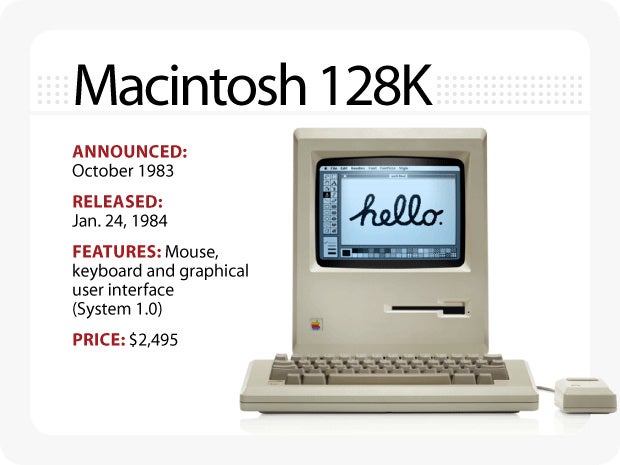
Computerworld / Apple
Macintosh 128K
The original Macintosh went on sale two days after Apple's critically acclaimed 1984 adaired during the third quarter of Super Bowl XVIII. Apple’s Macintosh 128K aimed to fundamentally change how consumers viewed computers and make them more affordable, personal and commonplace. It used a Motorola 68000 microprocessor, 128KB of RAM and a 400KB 3.5-inch floppy disk drive. The Mac’s OS, known as System 1.0, introduced the Finder that is still used today.
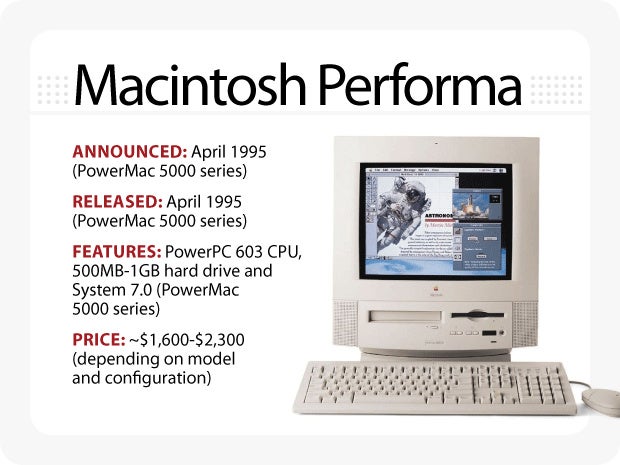
Computerworld / Apple
Macintosh Performa
Apple's Performa sold mainly through authorized retailers in department stores throughout the mid-1990s. Although not a new model, the Performa was a rebranding of then-existing Mac models, including the Classic, Quadra, Centris, LC, and Power Macintosh, and was meant for everyday users. The marketing tactic backfired, however, as the large number of models (in addition to those for business) competed with one another, and created customer confusion. The Performa line was also criticized for its lack of power and hardware design. Apple finally nixed it in the late 1990s and simplified its products by offering a desktop and laptop for both the professional market (Power Macintosh G3 and PowerBook) and for consumers (iMac and iBook).

Computerworld / Apple
iMac G3
After Steve Jobs’ return as CEO, Apple’s futuristic and design-conscious concept, dubbed the iMac G3, brought the company back from financial hardship. Built using a translucent “Bondi Blue” plastic, it featured a 15-inch CRT display, a PowerPC G3 processor, an ATI Rage IIc graphics processor, a 4GB hard drive, a tray-loading CD-ROM drive that replaced the traditional floppy disk drive, USB ports (to much criticism), an infrared port, built-in stereo speakers, two headphone ports, a redesigned keyboard and mouse, and Mac OS 8. The iMac G3 became a cultural phenomenon and had several iterations and upgrades over the next few years (including a slimmer model).

Computerworld / Apple
iMac G4
Designed around an ultra-compact base, the iMac G4’s one-inch thin flat-panel display appeared to float in mid-air, allowing users to adjust its height or angle with just a touch. This was a big deal, since PCs (and earlier iMacs) still used outdated, clunky CRT displays. The all-in-one machine used a PowerPC G4 processor, an NVIDIA GeForce 2MX graphics processor and ran OS X Jaguar.
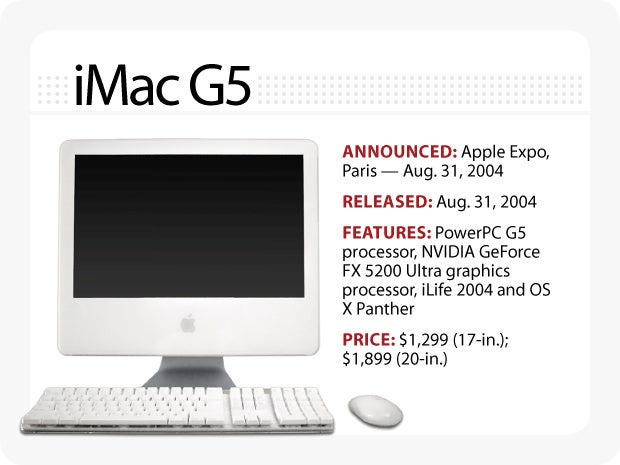
Computerworld / Apple
iMac G5
Inspired by the iPod, Apple unveiled its polycarbonate white iMac G5 at the Apple Expo in Paris. The display was suspended from its anodized aluminum stand, making for a very small footprint, and unlike its predecessor, the entire computer was integrated into the flat-panel display. Just two inches thick, Apple dubbed it the world’s thinnest desktop computer. It included a built-in SuperDrive, a PowerPC G5 processor, an NVIDIA GeForce FX 5200 Ultra graphics processor, iLife 2004 and OS X Panther.

Computerworld / Apple
iMac G5 (with Intel)
Apple changed the game with an updated iMac that used, for the first time, Intel processors. As Apple noted, it forged “a historic partnership between the world’s leading chip innovator and the world’s most innovative computer company.” The thinner and lighter G5 included an ATI Radeon X1600 graphics processor, an iSight camera for video chats, Front Row entertainment software with a Remote for viewing slideshows and movies, iLife ’06, an updated Mighty Mouse and OS X Tiger.
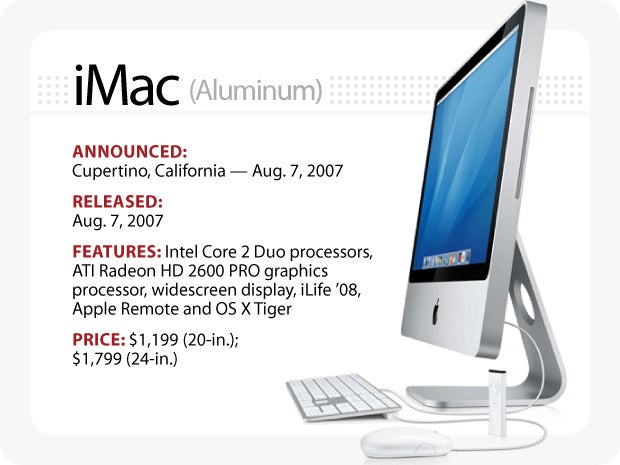
Computerworld / Apple
iMac (Aluminum)
Apple’s next major redesigned iMac melded glass and aluminum for a more contemporary look that stuck as a placeholder for its successors. It sported Intel Core 2 Duo processors, an ATI Radeon HD 2600 PRO graphics processor, a glossy widescreen display, iLife ’08 and OS X Tiger. Apple also included its redesigned keyboard, Mighty Mouse and Apple Remote.

Computerworld / Apple
iMac (Aluminum Unibody)
This aluminum model was notable for its unibody design and 16:9 high-definition display. Unlike the previous generation, the iMac’s screen was edge-to-edge glass. It included Intel Core 2 Duo processors with a NVIDIA GeForce 9400M integrated graphics processor and shipped with OS X Snow Leopard. Additionally, Apple included its new wireless accessories: an Apple Keyboard and a Magic Mouse.
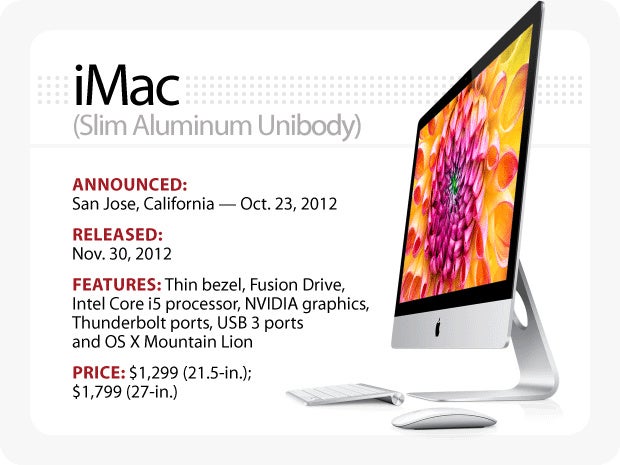
Computerworld / Apple
iMac (Slim Aluminum Unibody)
Apple released its thinnest iMac (with a 5mm edge), taking up as much as 40% less volume than the previous generation and featuring a new Fusion Drive – a storage option that combined a high-capacity hard drive with high-performance flash storage. It included third-generation, quad-core Intel Core i5 processors, the latest NVIDIA graphics, Thunderbolt ports, new storage options, USB 3 ports and OS X Mountain Lion. It also used 50% less energy at idle with the display on than previous models. Because of its radically thin design, this iMac also banished the SuperDrive in favor of its digital hub via iTunes and the App Store.

Computerworld / Apple
iMac (with Retina Display)
Apple released its first iMac with Retina display three years after the hi-def screens first appeared in its MacBook Pro line. With 14.7 million pixels, the 5120x2880-pixel resolution had four times as many pixels as its predecessor. It included sixth-generation Intel Core processors, the latest AMD graphics, a wider P3-based color gamut, an advanced Fusion Drive, Thunderbolt 2 ports and faster Wi-Fi. This generation also incorporated an advanced timing controller that had four times the bandwidth of the previous model and included OS X Yosemite. The 21.5-in. Retina 4K display was introduced a few months later, along with OS X El Capitan and new desktop accessories: the new Magic Keyboard, Magic Mouse 2 and Magic Trackpad 2 -- all of which were redesigned with internal batteries that could be recharged with a lightning cable.
![Evolution of the Macintosh - iMac Pro [2017]](https://images.idgesg.net/images/article/2017/06/evolution_of_the_macintosh_12-100725348-large.jpg)
Computerworld / Apple
iMac Pro
Apple announced a special sneak peak of the new iMac Pro at WWDC 2017. Dubbed the most powerful Mac ever, it features 8-, 10-, and 18-core Xeon processor configurations, Turbo Boost up to 4.5GHz, up to 42MB cache, and Radeon Pro Vega graphics with 11 teraflops single precision, 22 teraflops half precision, and 8GB or 16GB High Bandwidth Memory with 400 GB/s memory bandwidth. It includes up to 128GB 2666MHz DDR4 ECC memory in replace of SDRAM. Users can also choose up to 4TB SSD with 3GB/s throughput. This model includes Thunderbolt 3 ports that can control up to 44 million pixels and a 10Gb Ethernet port. Its 14.7 million pixel Retina 5K display has been updated with 500 nits of brightness (43% brighter) and P3 color gamut for support for over a billion colors. To compensate for all those powerful specs, it has a redesigned thermal architecture for 75% more airflow. It features enhanced stereo speakers for better frequency response, richer bass, and more volume. And let’s address the elephant in the room: the iMac Pro comes in a new color -- a gorgeous space gray -- with matching accessories of course. A new Magic Keyboard with Numeric Keypad also gives users a new choice over the standard Magic Keyboard. It starts at a whopping $4,999 and went on sale in mid-December. But prices can climb quickly into the five-digit range. (Check out our Mingis on Tech episode devoted to the iMac Pro.)



